Videoconferencing technology is used in connection with both spoken-language and sign-language interpreting and across different fields of interpreting, including business, conference, and public service or community interpreting.
In an article written by Vijayalaxmi Hegde on 26 August 2013 for CSA, she explains ‘Top ranking interpreting companies see definite revenue opportunities in the very near future in VRI. The VI market in US$ was 410,38 million in 2013, which was only 2% of the overall language service industry in the US’.
Now we are two years further on and the technology has greatly improved, so why not take advantage of this opportunity to have an updated look at Video Remote Interpreting (VRI).
In the US, VRI is an accepted and commonly used practice in the healthcare and legal fields. Medical interpreting in particular represents a growing market. There are 2,300 certified medical interpreters (CMI) serving hospitals, community clinics, psychiatric facilities, and public health departments on a daily basis, on-site and off-site.
A lot of US citizens and residents who do not speak English as their primary language and who have a limited ability to read, speak, write, or understand English (Limited English Proficient) prefer to communicate with a live person who can speak their native language. The evolving field of virtual interpreters is supporting hospitals by facilitating clearer medical conversations to ensure that patients receive the highest quality care regardless of language barriers, cultural backgrounds, or disabilities.
This also has a direct impact on the patient’s level of understanding, compliance, and trust, which can all help towards the overall success of the desired treatment.
Mr. Louis Provenzano, a co-founder of the National Board of Certified Medical Interpreters (US) and CEO of China Development Partners, has expressed his expectations for the current year, 2015: ‘An exponential and rapid growth in the number of certified medical interpreters’ and ‘greater numbers of hospitals will insist that their staff interpreters become nationally certified’.
In my opinion, here lies an open field of opportunities for, especially, interpreters outside the US with an interest in medical or legal interpretation. The fact that in the US, every person who has only limited knowledge of the English language has the right to an interpreter by law (Title VI of the Civil Rights Act), paves a path for other countries to follow.
If you look at the website of the aforementioned CMI or similar recognised institutions like IMIA or CCHI, you will find a good range of training courses and accredited programs.
It is interesting to see that some Asian languages are also offered by CMI in their Medical Interpreter training program; for instance, besides Spanish and Russian, they also offer Mandarin, Cantonese, Korean and Vietnamese.
Wouldn’t it be great if VRI could be implemented in healthcare and other settings in the diverse continent of Asia, with all its different languages, speeches, and tongues?
I can see some great opportunities here so why not take a look at those websites and see if you share my opinion?
























